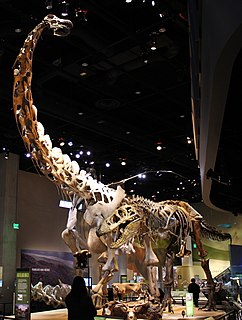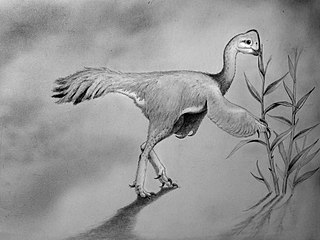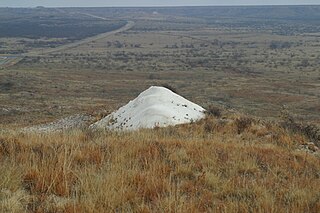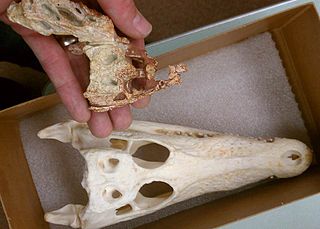 W
WPaleontology in Texas refers to paleontological research occurring within or conducted by people from the U.S. state of Texas. Author Marian Murray has remarked that "Texas is as big for fossils as it is for everything else." Some of the most important fossil finds in United States history have come from Texas. Fossils can be found throughout most of the state. The fossil record of Texas spans almost the entire geologic column from Precambrian to Pleistocene. Shark teeth are probably the state's most common fossil. During the early Paleozoic era Texas was covered by a sea that would later be home to creatures like brachiopods, cephalopods, graptolites, and trilobites. Little is known about the state's Devonian and early Carboniferous life. However, evidence indicates that during the late Carboniferous the state was home to marine life, land plants and early reptiles. During the Permian, the seas largely shrank away, but nevertheless coral reefs formed in the state. The rest of Texas was a coastal plain inhabited by early relatives of mammals like Dimetrodon and Edaphosaurus. During the Triassic, a great river system formed in the state that was inhabited by crocodile-like phytosaurs. Little is known about Jurassic Texas, but there are fossil aquatic invertebrates of this age like ammonites in the state. During the Early Cretaceous local large sauropods and theropods left a great abundance of footprints. Later in the Cretaceous, the state was covered by the Western Interior Seaway and home to creatures like mosasaurs, plesiosaurs, and few icthyosaurs. Early Cenozoic Texas still contained areas covered in seawater where invertebrates and sharks lived. On land the state would come to be home to creatures like glyptodonts, mammoths, mastodons, saber-toothed cats, giant ground sloths, titanotheres, uintatheres, and dire wolves. Archaeological evidence suggests that local Native Americans knew about local fossils. Formally trained scientists were already investigating the state's fossils by the late 1800s. In 1938, a major dinosaur footprint find occurred near Glen Rose. Pleurocoelus was the Texas state dinosaur from 1997 to 2009, when it was replaced by Paluxysaurus jonesi after the Texan fossils once referred to the former species were reclassified to a new genus.
 W
WAcrocanthosaurus is a genus of theropod dinosaur that existed in what is now North America during the Aptian and early Albian stages of the Early Cretaceous. Like most dinosaur genera, Acrocanthosaurus contains only a single species, A. atokensis. Its fossil remains are found mainly in the U.S. states of Oklahoma, Texas, and Wyoming, although teeth attributed to Acrocanthosaurus have been found as far east as Maryland, suggesting a continent wide range.
 W
WThe Aguja Formation is a geological formation in North America, exposed in Texas, United States and Chihuahua and Coahuila in Mexico, whose strata date back to the Late Cretaceous. Dinosaur remains are among the fossils that have been recovered from the formation.
 W
WAgujaceratops is a genus of horned dinosaur from the Late Cretaceous (Campanian) of west Texas. It is a chasmosaurine (long-frilled) ceratopsian. Two species are known, Agujaceratops mariscalensis, and A. mavericus.
 W
WAlamosaurus is a genus of potentially opisthocoelicaudiine titanosaurian sauropod dinosaurs, containing a single known species, Alamosaurus sanjuanensis, from the late Cretaceous Period of what is now southern North America. Isolated vertebrae and limb bones indicate that it reached sizes comparable to Argentinosaurus and Puertasaurus, which would make it the largest dinosaur known from North America. Its fossils have been recovered from a variety of rock formations spanning the Maastrichtian, though fossils of Alamosaurus that date back to the Campanian have been unearthed, age of the late Cretaceous period. Specimens of a juvenile Alamosaurus sanjuanensis have been recovered from only a few meters below the Cretaceous-Paleogene boundary in Texas, making it among the last surviving non-avian dinosaur species.
 W
WAngulomastacator is a genus of duck-billed dinosaur from the Campanian-age Aguja Formation of Big Bend National Park, Texas. It is known from a single specimen, TMM 43681–1, a partial left maxilla. This bone is curved down approximately 45° at its anterior end, with the tooth row bent to fit, unlike any other hadrosaur. The unusual characteristics of the maxilla, which have not been reported from elsewhere, supports the hypothesis that the dinosaurs of the Aguja Formation were endemic forms. It was discovered in the upper shale member of the Aguja Formation, among plant, bone, and clam fragments in a bed interpreted as the deposits of a small tributary channel. This bed is just below rocks of the overlying Javelina Formation. Volcanic rocks at about the same level have been dated to 76.9 ± 1.2 million years ago.
 W
WAraeoscelis is an extinct genus of reptile, and one of the earliest diapsids. Fossils have been found in the Nocona, Arroyo and Waggoner Ranch Formations in Texas, dating to the Early Permian. Two species have been described, A. casei and A. gracilis.
 W
WThe Black Peaks Formation is a geological formation in Texas whose strata date back to the Late Cretaceous. Dinosaur remains have been among the fossils reported from the formation. The boundary with the underlying Javelina Formation has been estimated at about 66.5 million years old. The formation preserves the rays Rhombodus and Dasyatis, as well as many gar scales.
 W
WThe Brazos Valley Museum of Natural History is a science, nature and cultural history museum in Bryan, Texas, United States. The museum also maintains memberships in American Alliance of Museums, Natural Science Collections Alliance, and the Society for the Preservation of Natural History Collections.
 W
WThe Centennial Museum and Chihuahuan Desert Gardens is a cultural history and natural history museum on the campus of the University of Texas at El Paso in El Paso, Texas, United States.The museum was built in 1963 to commemorate the centenary of Texas independence, making it the oldest museum in El Paso.
 W
WThe Cherry Canyon Formation is a geologic formation found in the Delaware Basin of southeastern New Mexico and western Texas. It contains fossils characteristic of the Guadalupian Age of the Permian Period.
 W
WCimoliopterus is a genus of pterodactyloid pterosaur from the Cretaceous of England, United Kingdom and Texas, United States.
 W
WDinosaur Valley State Park is a state park near Glen Rose, Texas, United States.
 W
WThe Fort Worth Museum of Science and History is located on 1600 Gendy Street, Fort Worth, Texas 76107 in the city's Cultural District. It was opened in 1945 as the Fort Worth Children's Museum and moved to its current location in 1954. In 1968, the museum adopted its current name. Attractions at the museum include the Noble Planetarium and the Omni Theater, with Star's Cafe and Shop Too! gift shop, in addition to both traveling and permanent science and history exhibits.
 W
WThe Glen Rose Formation is a shallow marine to shoreline geological formation from the lower Cretaceous period exposed over a large area from South Central to North Central Texas. The formation is most widely known for the dinosaur footprints and trackways found in the Dinosaur Valley State Park near the town of Glen Rose, Texas, southwest of Fort Worth and at other localities in Central Texas.
 W
WThe Goliad Formation (Tg) is a geologic formation in Texas. It preserves fossils dating back to the Serravallian to earliest Pliocene stages of the Neogene period, including the gomphothere Blancotherium among many other fossil mammals, reptiles, birds and fish.
 W
WGustafsonia is an extinct genus of carnivoran belonging to the family Amphicyonidae. The type species, Gustafsonia cognita, was described in 1986 by Eric Paul Gustafson, who originally interpreted it as a miacid and named it Miacis cognitus. It was subsequently considered to be the only species of the diverse genus Miacis that belonged to the crown-group Carnivora, within the Caniformia, and it was ultimately assigned to the family Amphicyonidae. The type specimen or holotype was discovered in Reeve's bonebed, western Texas, in the Chambers Tuff Formation in 1986. The University of Texas holds this specimen. It is the only confirmed fossil of this species.
 W
WThe Hannold Hill Formation is an Early Eocene (Wasatchian) geologic unit in the western United States. It preserves the fossilized remains of the ray Myliobatis and gar.
 W
WFounded in 1967, the Heard Natural Science Museum & Wildlife Sanctuary is located in McKinney, Texas, United States. With a 289-acre wildlife sanctuary, five miles of hiking trails, about fifty acres of wetlands, a two-acre native plant garden, a butterfly house, live animals, indoor and outdoor exhibits, the Heard welcomes over 100,000 visitors annually. The Heard is one of the most important attractions in the City of McKinney.
 W
WThe Houston Museum of Natural Science is a natural history museum located on the northern border of Hermann Park in Houston, Texas, United States. The museum was established in 1909 by the Houston Museum and Scientific Society, an organization whose goals were to provide a free institution for the people of Houston focusing on education and science. Museum attendance totals over two million visitors each year. The museum complex consists of a central facility with four floors of natural science halls and exhibits, the Burke Baker Planetarium, the Cockrell Butterfly Center, and the Wortham Giant Screen Theatre. The museum is one of the most popular in the United States and ranks just below New York City's American Museum of Natural History and Metropolitan Museum of Art and the M. H. de Young Memorial Museum in San Francisco in most attendance amongst non-Smithsonian museums. Much of the museum's popularity is attributed to its large number of special or guest exhibits.
 W
WIgnacius is a genus of extinct mammal from the early Cenozoic era. This genus is present in the fossil record from around 62-33 Ma. The earliest known specimens of Ignacius come from the Torrejonian of the Fort Union Formation, Wyoming and the most recent known specimen of Ignacius was found in the Medicine Pole Hills of North Dakota. Ignacius is one of ten genera within the family Paromomyidae, the longest living family of any plesiadapiforms, persisting for around 30 Ma during the Paleocene and Eocene epochs. The analyses of postcranial fossils by paleontologists suggest that members of the family Paromomyidae, including the genus Ignacius, most likely possessed adaptations for arboreality.
 W
WThe Javelina Formation is a geological formation in Texas. Dating has shown that the strata date to the Maastrichtian stage of the Late Cretaceous, approximately 70 to 66.5 million years old. The middle part of the formation has been dated to about 69 million years ago plus or minus 1 Ma and the top situated near the Cretaceous–Paleogene boundary, dated to 66 Ma ago. Dinosaur remains are among the fossils that have been recovered from the formation.
 W
WThe Laredo Formation is a geologic formation and Lagerstätte in Texas, United States and Nuevo León and Tamaulipas, Mexico. It preserves fossils dating back to the Lutetian stage of the Eocene period. Among many other fossils, the formation has provided invertebrates, vertebrates, leaves, pollen and spores and fossil wood of the brackish water palm Nypa sp.
 W
WLeptorhynchos is an extinct genus of caenagnathid dinosaurs known from the Late Cretaceous Aguja Formations of west Texas United States. It lived about 80.5–72 million years ago. It is distinguished from its relatives Chirostenotes and Anzu by its smaller size, and by a more strongly upturned mandible, similar to that of oviraptorids. The specializations of the beak in Leptorhynchos and other caenagnathids suggest that they were herbivores. The species L. elegans has since been transferred to the genus Citipes.
 W
WLubbock Lake Landmark, also known as Lubbock Lake Site, is an important archeological site and natural history preserve in the city of Lubbock, Texas. The preserve is 336 acres and is a protected state and federal landmark. There is evidence of ancient people and extinct animals at Lubbock Lake Landmark. It has evidence of nearly 12,000 years of use by ancient cultures on the Llano Estacado. It is run by the Museum of Texas Tech University.
 W
WThe Mayborn Museum Complex is a 142,000-square-foot (13,200 m2) facility that opened in May 2004 at Baylor University in Waco, Texas. It features a natural history museum focusing on Central Texas with walk-in dioramas including one on the Waco Mammoth Site, and exploration stations for geology, paleontology, archeology, and natural history. Sixteen themed discovery rooms encourage hands-on learning for all ages. The complex also includes a 13-acre (53,000 m2) historic village, a 5,000 sq ft (460 m2) traveling exhibit gallery, a theater, a museum store, and a snack area.
 W
WMount Blanco is a small white hill — an erosional remnant — located on the eastern border of the Llano Estacado within Blanco Canyon in Crosby County, Texas. With Blanco Canyon, it is the type locality of the Blanco Formation of Texas and Kansas, as well as the Blancan fauna, which occurs throughout North America.
 W
WNotharctus is a genus of adapiform primate that lived in North America and Europe during the late to middle Eocene.
 W
WThe Paw Paw Formation is a geological formation in Texas whose strata date back to the late Albian stage of the Early Cretaceous. Dinosaur remains are among the fossils that have been recovered from the formation.
 W
WPawpawsaurus, meaning "Pawpaw Lizard", is a nodosaurid ankylosaur from the Cretaceous of Tarrant County, Texas, discovered in May 1992. The only species yet assigned to this taxon, Pawpawsaurus campbelli, is based on a complete skull from the marine Paw Paw Formation.
 W
WThe Perot Museum of Nature and Science is a natural history and science museum located in Dallas, Texas. It consists of two campuses: the primary campus located in Victory Park, and a secondary campus in Fair Park. The Victory Park campus museum was named in honor of Margot and Ross Perot. The current chief executive officer of the museum is Dr. Linda Abraham-Silver.
 W
WThe Road Canyon Formation is a geologic formation in Texas. It preserves fossils dating back to the Permian period.
 W
WSauroposeidon is a genus of sauropod dinosaur known from several incomplete specimens including a bone bed and fossilized trackways that have been found in the American states of Oklahoma, Wyoming, and Texas.
 W
WTexacephale is a pachycephalosaurid dinosaur from the Campanian stage of the Late Cretaceous. Its fossils come from the Aguja Formation of Big Bend National Park, in Texas, and were described in 2010 by Longrich, Sankey and Tanke. The generic name means Texas + "head" in reference to its place of discovery, and the specific name honors Wann Langston.
 W
WThe Texas Memorial Museum, located on the campus of the University of Texas at Austin in Austin, Texas, USA, was created during preparations for the Texas Centennial Exposition held in 1936. The museum's focus is on natural history, including paleontology, geology, biology, herpetology, ichthyology and entomology. At one point, the museum also had exhibits on Texas history, anthropology, geography, and ethnography, but these were relocated to other museums in 2001.
 W
WThe Museum of Texas Tech University is part of Texas Tech University in Lubbock, Texas. It is made up of the main museum building, the Moody Planetarium, the Natural Science Research Laboratory, the research and educational elements of the Lubbock Lake Landmark, and the Val Verde County research site. It features collections in anthropology, fine arts, clothing and textiles, history, natural sciences and paleontology.
 W
WThe Waco Mammoth National Monument is a paleontological site and museum in Waco, Texas, United States where fossils of 24 Columbian mammoths and other mammals from the Pleistocene Epoch have been uncovered. The site is the largest known concentration of mammoths dying from a (possibly) reoccurring event, which is believed to have been a flash flood. The mammoths on site did not all die at the same time but rather during three separate events in the same area. A local partnership developed around the site after the initial bone was discovered. The Waco Mammoth Foundation worked in partnership with the city of Waco and Baylor University to develop the site. Baylor's involvement mainly included the research, preservation, and storage of materials from the site, while the city of Waco contributed to the protection of the land. In 2015, they successfully sought the National Monument designation to bring the expertise of the National Park Service into the partnership.
 W
WThe Waggoner Ranch Formation is a geologic formation in northern Texas. It preserves fossils dating back to the Artinskian to Kungurian stages of the Permian period.
 W
WWannchampsus is an extinct genus of paralligatorid neosuchian, close to but not a true crocodilian. It is known from fossils discovered in Lower Cretaceous rocks in north-central Texas, United States.
 W
WThe Word Formation is a geologic formation in Texas. It preserves fossils dating back to the Permian period. It is probably named for the Old Word Ranch in the Glass Mountains of Brewster County.